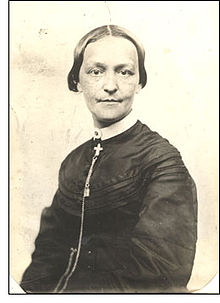Partner Ellen E. Miles
Queer Places:
Orleans Cemetery, Phelps, Ontario County, New York, USA
 Phebe
Ann Coffin Hanaford (May 6, 1829 - June 2, 1921) may be America's earliest certifiable lesbian minister.
According to Lisa M. Tetrault, Hanaford was
born in Siasconset on Nantucket Island on May 6, 1829, the only child of the
merchant and shipowner George W. Coffin and his wife Phebe Ann Barnardn. Both were Quakers and direct descendants of the island's first white
settlers, Tristram Coffin and Peter Folger.
Phebe
Ann Coffin Hanaford (May 6, 1829 - June 2, 1921) may be America's earliest certifiable lesbian minister.
According to Lisa M. Tetrault, Hanaford was
born in Siasconset on Nantucket Island on May 6, 1829, the only child of the
merchant and shipowner George W. Coffin and his wife Phebe Ann Barnardn. Both were Quakers and direct descendants of the island's first white
settlers, Tristram Coffin and Peter Folger.
Beginning in 1857, Phebe began to live in other towns on mainland
Massachusetts, with her husband Dr. Joseph Hanaford. During the 1850s and
1860s, as Phebe raised her children, she became a highly successful author,
and later gave her first sermons, having joined the Unitarian ministry. While
visiting Nantucket in 1865, she accepted her father's invitation to give her
first sermon. A year later, she was "surprised and honored,"
when asked to substitute in South Canton, New York, for the Rev. Olympia
Brown, the first ordained Universalist woman minister. "I dared not refuse to
go," she said, "it seemed to be the Lord's call. [So] I
went." Phebe separated from her husband and accepted a position with the First
Universalist Church of New Haven, Connecticut, in 1870, at an annual salary of
$2,000. That same year she served as chaplain for the
Connecticut Legislature.
At the time she first took the pulpit, Hanaford was also becoming an
important leader in the women's rights movement. Together with other leaders
of a feminist-abolitionist coalition, such as
Lucy Stone,
Julia Ward Howe,
Thomas Wentworth Higginson, and William Lloyd Garrison, she helped establish
the American Woman Suffrage Organization (1869). In the following decade, when
Hanaford accepted a position with the Universalist Church of the Good Shepherd
in Jersey City, NJ, the congregation split, ostensibly over her
women's rights activities. Legend has it that her political activism alienated
her congregation. She refused a demand to abandon politics, and in 1877 a majority of voting members failed to reappoint her.
Hanaford then formed a second Universalist society at a rented auditorium and
preached there for the next several years.
"Hanaford's letters and papers, however, offer a somewhat different
explanation for the split," says Lisa Tetrault. "Hanaford had begun living
with a woman named Ellen E. Miles
(1838-1914). Newspaper clippings preserved in
Hanaford's scrapbook reported that the disgruntlement among congregation
members was, in fact, over Hanaford's liaison with Miles, whom the papers
called the 'minister's wife.' Hanaford, it seems, was not simply asked to
cease her women's rights activities, but more specifically, to 'dismiss'
Miss Miles... their letters testify to a deep and abiding affection. The
two remained life-long companions, separated after forty-four years
together only by Miles's death in 1914."
Hanaford published a poem in 1870 as a dedicatory sonnet at the
beginning of From Shore to Shore:
To Ellen Miles
Friend of my later years, whose tender love
Has
filled my home with blossoms, sweet though late,
Whose noble heart my
spirit must approve,
As Duty’s path thou tread’st with willing feet:
Thy welcome service, at Love’s bidding mine,
As these my rhythmic waifs
are gathered now,
Calls for a grateful tribute, and I twine
This
simple wreath, dear Nellie, for thy brow.
Soul-sister! may the waiting
years for thee
Pour out a largess of such holy joy
That earth shall
seem the porch of heaven to be,
And songs of praise thy tuneful lips
employ!
Then, while eternal years shall onward roll,
Still may we
share Love’s summer of the soul!
When Miles died in 1914 her newspaper obituary read: “. . .she [Phebe]
and Miss Miles formed a very intimate personal friendship which continued
without interruption so long as Miss Miles lived. She was a woman of
exceedingly kindly nature, conscientious in her life, strong in her
friendships, and inflexible in her sense of duty.”
My published books:


BACK TO HOME PAGE

- https://lgbtqreligiousarchives.org/profiles/phebe-ann-coffin-hanaford
- "A Paper Trail: Piecing Together the Life of Phebe Hanaford," by Lisa
M. Tetrault:
http://www.nha.org/history/hn/HNhanaford.htm
 Phebe
Ann Coffin Hanaford (May 6, 1829 - June 2, 1921) may be America's earliest certifiable lesbian minister.
According to Lisa M. Tetrault, Hanaford was
born in Siasconset on Nantucket Island on May 6, 1829, the only child of the
merchant and shipowner George W. Coffin and his wife Phebe Ann Barnardn. Both were Quakers and direct descendants of the island's first white
settlers, Tristram Coffin and Peter Folger.
Phebe
Ann Coffin Hanaford (May 6, 1829 - June 2, 1921) may be America's earliest certifiable lesbian minister.
According to Lisa M. Tetrault, Hanaford was
born in Siasconset on Nantucket Island on May 6, 1829, the only child of the
merchant and shipowner George W. Coffin and his wife Phebe Ann Barnardn. Both were Quakers and direct descendants of the island's first white
settlers, Tristram Coffin and Peter Folger.
